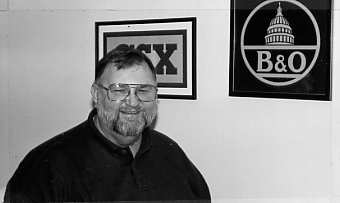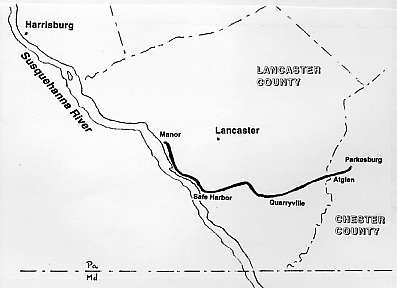March 2005
Runs to Frostburg Will End, Western Maryland Scenic Says
The Western Maryland Scenic Railroad has announced that it plans to
discontinue making runs with its excursion train through to Frostburg at
the end of the 2005 season. "We should emphasize that the train will
continue to run, but this will be the final season that it travels all
the way to Frostburg," said Barbara Buehl, director of the Allegany
County Chamber of Commerce, as quoted in the February 19 edition of the
Cumberland Times-News. Financial concerns were cited for the decision,
including the loss of a state subsidy for maintenance costs in 2006. It
was also reported that the railroad may need a new maintenance facility.
It was not disclosed what the destination will be once the Frostburg end-point
is eliminated.
Sonny Clodfelter Dies
[By Allen Brougham] . . .

Hoy Derwood Clodfelter, veteran B&O tower operator and agent, died
January 9 at the age of 72. Known by his nickname of Sonny, which had been
with him from about the age of seven, he had retired following 41 years
of railroad service in March 1993.
Sonny began his career on the railroad in December 1951 as a leverman
at CX Tower in Baltimore. He also worked as a leverman at nearby Lee Street
before advancing to the position of operator. His first operator's assignment
was at BX Tower near Baltimore's Curtis Bay yard, and he also worked extra
operator positions in the Baltimore area at Westport, Waverly, Riverside
and Bay View.
His first regular job was the midnight position at A Tower in Aberdeen,
Maryland, to and from which he often traveled by train.
In September 1963 Sonny took a regular roving-relief position which
involved his going to different assigned locations each day of his work
week. Also called a "Rabbit Turn" because the operator would
literally hop from place to place, it involved offices distantly spaced
from JD Tower in Hyattsville, Maryland, to WJ Tower in Wilmington, Delaware.
In 1967 the trek to Wilmington was eliminated and substituted instead by
a day at QN Tower in Washington, D.C. In addition to QN and JD, Sonny saw
duty each week at BX Tower, Riverside and Bay View. It still involved a
lot of travel, and there was no one office to which Sonny could call "home,"
but the position provided him with a great deal of variety which he enjoyed.
Then, in 1983, upon the retirement of Arthur Vance, Sonny took the daylight
position at Bay View. He now had a place to call "home," and
it also was a job in which he could enjoy having both Saturday and Sunday
off. When Bay View closed in 1984, Sonny was the operator on duty who closed
it.
He then took a position as a freight loss and damage inspector. Later,
in 1990, he became a ticket agent at the MARC commuter station at Odenton,
Maryland, and held that position until he retired.
Although Sonny held no further tower positions after 1984, he did maintain
qualification as an operator and was often called upon to work weekend
and holiday vacancies at towers he had formerly served that were still
open. All have since closed. His duty at those places kept an uplifting
spirit among the younger operators who looked upon Sonny as an elder statesman
within their ranks.
Until 1984 Sonny worked exclusively in the towers. But on a couple of
occasions in the early part of his career he did get called upon to substitute
as a freight agent when nobody else was available. Not being a qualified
agent, he could do little more than distribute paychecks and answer the
phone. If a complex matter developed, he would try to satisfy the situation
as best he could. On one such occasion, while at Mount Airy, Maryland,
someone called Sonny to ask how much it would cost to ship about 60 sheep
to California. It was actually a gag perpetrated by the late Tom Landers,
one of Sonny's co-workers, but it caused Sonny some anxious moments while
he attempted to serve the inquiry.
Some more anxious moments occurred during Sonny's tenure at A Tower.
It seems he once dozed off and caused a hotshot westbound freight to get
stopped. It was No. 91, which had only recently been elevated to priority
status, and Sonny knew that delays to it would not be looked upon lightly.
He quickly gave the train the signal, and then reported the train passing
the tower with a slightly "fudged" time in the hope that this
might obscure the train's delay. In turn, he asked Ralph Fisher at Poplar
Tower, the next tower to the west, if he could fudge his time as well.
Ralph agreed. But when Ralph reported the train by his station just 23
minutes later, a rather fast run, Sonny called Ralph to say: "Thanks,
but you didn't have to fudge the time by THAT much!" Ralph replied
by saying that he hadn't fudged the time at all... The train had made a
fast enough run to more than cover Sonny's nap-incurred delay.
When he retired in 1993, Sonny said his career with the railroad had
been tremendously rewarding. Given the opportunity, he would have done
it all over again.
Trail Planned for Former PRR Atglen & Susquehanna Branch
In a process that has taken over 15 years to date, the Surface Transportation
Board has granted Norfolk Southern the right to abandon the 33.9-mile former
Pennsylvania Railroad's Atglen & Susquehanna Branch between Parkesburg
(MP 0.0) and Manor Township (MP 33.9) in Pennsylvania. This opens at least
the opportunity for all or part of the right of way to be converted into
a recreational use trail. In a decision dated January 19, the STB concluded
that a final memorandum of agreement had been executed and filed with the
Advisory Council for Historic Preservation, thus allowing the railroad
to "fully abandon the line."
The line - a portion of what was traditionally known as the "Low
Grade" line - passes through the townships of West Sadsbury, Sadsbury,
Bart, Eden, Providence, Martic and Conestoga, and the borough of Quarryville.
The branch was originally petitioned for abandonment in 1989 by Conrail,
then owner of the line, through the Interstate Commerce Commission, predecessor
to the STB. Approval was granted the following year for abandonment of
the entire branch, except for the bridges. By excluding the 83 bridges
- the only properties on the line that had then been identified as "historic"
- the ICC required the railroad to retain interest pending completion of
a historic review process.
Later, in 1996, Conrail sold a portion of the line, between MP 1.5 and
MP 4.0.
While procedural requirements of the National Historic Preservation
Act continued, a petition was filed with the Surface Transportation Board
by the Friends of the Atglen-Susquehanna Trail to reopen the proceeding
and broaden the historic review process to include the entire line, not
just the bridges. In 1997, the petition was denied, and a further petition
for reconsideration was similarly denied two years later. The Friends of
the Atglen-Susquehanna Trail then took the matter to court, and in 2001
a U.S. Court of Appeals ruled that the STB had "failed to comply fully"
with the National Historic Preservation Act, and ordered the board to broaden
the historic review process.
This paved the way for further analysis and a determination that the
entire branch - and not just the bridges - was "historic." Public
meetings were held, and the final memorandum of agreement was presented
in April 2004 and signed in July by the Advisory Council for Historic Preservation,
the Pennsylvania State Historic Preservation Officer, STB's Section of
Environmental Analysis, Norfolk Southern, and the townships of Martic,
Providence and Sadsbury.
In its January 19 decision, the STB ruled that its involvement in the
manner has been concluded - provided Norfolk Southern notifies the STB
within 60 days that it intends to consummate the abandonment - as the property
will no longer be part of the national rail transportation system. Further
negotiations and/or litigation - outside of the realm of the STB - over
transferring the property to new owners will now be free to commence. Lancaster
County, through which most of the line is situated, has already filed a
"declaration of taking" in its Common Pleas Court to exercise
eminent domain to acquire 930.2 acres of the right of way for trail purposes.
In a reply filed on January 7, 2005, the Friends of the Atglen-Susquehanna
Trail, which had taken the matter to court in the first place, stated that
it supports Lancaster County's preservation efforts.

According to its website, the Atglen-Susquehanna Trail is a rails-to-trails
conversion project that proposes to make use of the corridor stretching
about 23 miles across the southern end of the county, approximately from
Atglen to Safe Harbor. The organization conceived the idea to transform
the line into a hiking and biking trail in the early 1990s. Ever since,
it has been the subject of ongoing controversy and debate among recreation
and preservation groups, municipal officials, business owners, civic leaders
and residents. The State Department of Conservation and Natural Resources
has offered to provide the county with funding for the project.
The Atglen & Susquehanna Branch was constructed in the early 1900s
to funnel an increasing amount of freight traffic from the passenger line
serving Lancaster and Harrisburg. Actually one of about five different
branches under the single moniker of Low Grade, the Atglen & Susquehanna
was electrified in 1936, and was a busy, double-track line connecting Parkesburg
with the (still active) Columbia and Port Deposit line at Creswell, about
a mile geographically northwest of Safe Harbor. By way of a bridge nine
miles northwest of Creswell spanning the Susquehanna River between Shocks
Mills and Wago Junction, the trains could reach Enola Yard across the river
from Harrisburg. The Atglen & Susquehanna became redundant in the late
1980s, and in 1989 (using the name "Enola Branch") it was petitioned
for abandonment. Tracks were removed beginning in 1990.
NARP Responds to Trip Report Questions
The feature article entitled 'My Winter 2005 Amtrak Adventure,' appearing
in the February issue, posed a couple of questions to which the National
Association of Railroad Passengers was invited to offer comments. David
Johnson, assistant director, offered the following concerning: (1) the
quirky procedure for redeeming Guest Rewards points for a portion of a
trip by requiring the customer to coordinate the process through two different
agents, and (2) the scheduling of the Lake Shore Limited to leave New York
five minutes later than another train having more stops along the same
route, resulting in delays to the Lake Shore Limited...
- (1) "I agree that the process for redeeming a reward is cumbersome
and I will forward your comments to Amtrak."
- (2) "From what we understand, the schedules of trains 49 and
291 are at the insistence of Metro North, owner of the tracks between Spyten
Duyvil and Poughkeepsie. There is limited capacity on this railroad, and
Metro North wants the two trains as close together as possible. We'll review
this issue with Amtrak."
A third question - not included in the article, but asked of NARP nevertheless
- involved the Pacific Parlour cars, their heritage, and the disposition
of a sixth car from the original set that is no longer in service...
- (3) "Pacific Parlour cars were lounge cars. The hi-level dining
cars did not have the windows that wrap up over the ceiling and also had
an odd truck setup: one was four axles, one was six axles to accommodate
the on board diesel generator for dining room cooking power (pre-HEP).
I understand one of the [Parlour] cars is out of service for major wreck
damage."
Of Keystone Heritage
[By Rich BallasT] . . .
Just back from my first business trip to Germany since 1994, and of
course, when you travel in Germany, you do it by TRAIN! Yes. You know...
Those things we run only freight on over here, in the "more advanced"
country! 150 miles per hour, all-electrified, smooth trackage, on-time
performance, and even position light signals! And no, we didn't "sacrifice"
rail travel for our woefully inadequate interstate highway system, because
Germany's autobahn system doesn't even have a speed limit! Their system
is effectively designed so as to accept very high speeds, in an obviously
safe operating mode. It appears that a typical German highway operating
speed averages around 80 or 90 miles per hour. And if you want to take
this to the extreme, consider that Essen, the large, former extensively
industrialized city I visited for one week, maintains a wonderful city
streetcar, or what they call, "tram" system. Now let's consider
our region and Pittsburgh, a very comparable city. We have the dubious
distinction of "boasting" probably the lowest speed limit on
the whole of Interstate 70, between New Stanton and the Nevada desert,
45 miles per hour, due south of the city, around its crossing of the Mon
River (and for no apparent reason that I can see!). Our main road through
town is an antiquated, four lane, east-west road, built in 1948, and since
then unimproved, that bottles up for miles every morning and evening for
miles and miles, heaven forbid a one-car accident really screws things
up! (I sat there dead on the road with about a thousand other drivers,
engine off, for 30 minutes, inbound, at 3:30pm, one afternoon several weeks
ago!) We have no commuter rail service, despite the fact that all of the
ex-PRR, B&O and P&LE main lines radiating out of the city along
the three rivers are all intact and operable. Why? When Amtrak runs a train
from Pittsburgh to Chicago, every time I ride it, it is jammed full to
capacity. Yet it "isn't a viable run," and this month we will
(once again) lose the substituted B&O route which we lost in 1996!
And are these problems merely regional? How can West Virginia, mountainous
and curvy as its interstates are, boast a 70-mile per hour limit, while
ours are still mainly 55? Traveling west along I-70, the ex-PRR Panhandle
Mainline lies basically dead, paralleling a few miles to the north. 65
miles per hour on the road, we once had, what, 79 miles per hour on the
Pennsy mains? And west of Columbus, a ripped up high speed mainline westward
to Terre Haute!? Riding bicycles on it for leisure!? Bicycles!!?? Oh boy!!
(See me madly scratching the top of my head at this point) Sad... Sad...
Sad! Shame... Shame on us! It is absolutely heartbreaking when one is forced
to compare what we once had to a truly advanced country's operating transportation
systems! And when I see those position light signals over there, beautifully
illuminating the nighttime city railscape, it somehow magically takes me
back to the glory years I never saw here, and makes me better appreciate
what you lucky, lucky oldsters had the fortune to enjoy throughout that
wonderful century Of Keystone Heritage! - RDB
A Lesson in Tower Preservation
[By William A. Burke, Jr.] . . .
We certainly have a lot to learn...
Story and photos: CLICK HERE
Amtrak Announces Changes to Sunset Limited Schedule
Amtrak has announced schedule changes to the Sunset Limited in an effort
to improve the train's service reliability, according to the National Association
of Railroad Passengers. Effective March 8 and 9 respectively, the westbound
train will arrive Los Angeles four hours later, and the eastbound train
will depart Los Angeles eight hours earlier. Times east of New Orleans
will remain the same, at least until the spring schedule change in April.
Administration to Reintroduce its Passenger Rail Investment
Reform Act
U.S. Secretary of Transportation Norman Mineta says the Bush Administration
soon will reintroduce its 'Passenger Rail Investment Reform Act' to establish
a 50-50 federal match for state investments in passenger rail infrastructure,
create competition for passenger rail service and allow Amtrak to focus
on running the trains on time, according to a news release from the department.
My New Dog
[By Allen Brougham] . . .

Welcome into the family... CODY.
He is a mixed border collie and Eskimo dog. I got him from the Defenders
of Animal Rights in Jacksonville, Maryland, January 3. In fact, his adoption
from that office was the very first for the new year. He will be six years
old next month.
Cody enjoys fetching his toy for me, slobbering me on the face, high
jumping, playing 'catch me if you can,' sleeping in my lap, and walking
with me around the neighborhood.
His first day (quite mild for that time of year) included a three-mile
walk on the Northern Central Railroad Trail. So now I can say that we got
truly acquainted with a 'railroad flavor.'
For those who missed the news in the last issue: Rex, my hound dog,
died on New Year's Eve. Cody is not his 'replacement.' No dog can be replaced.
Each makes its own place in its own particular way.


